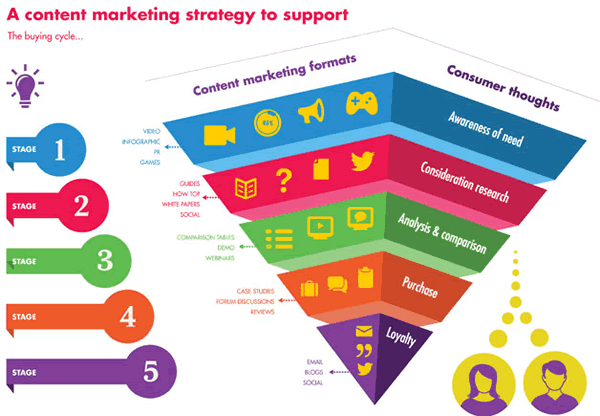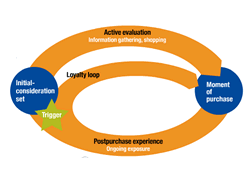
Just as is the case with other marketing tactics and in an integrated marketing approach, a content marketing strategy (not to be confused with a content strategy) is essential to succeed if you want to approach content marketing the correct (i.e. hype-free) way. Such a strategy is typically built around the buyer journey or customer journey during which buyers consult several content sources. And there are different ways to express and map that famous journey in content marketing and beyond. An integrated buyer’s journey that has clearly changed and keeps changing.
Admittedly, sometimes content marketing is used in another context, for instance the pure publishing sense whereby the creation, distribution, management, reporting and interaction with the content are put in the center. And more often than not it’s used in a context that’s not really about content marketing at all. But you know how it is with popular terms.
Some content marketing software platforms such as Cadence9, look at content marketing the publishing way and are essentially all about the idea of creating, managing and publishing across multiple platforms, including some other enterprise content marketing features. But they’re not integrated with, for instance, marketing automation or CRM. They look more at the content strategy, rather than the content marketing strategy.
However, in the strict sense, content marketing doesn’t focus on publishing but on using content in an integrated marketing – or customer – strategy. That’s where other platforms, such as Kapost and Marketing.ai come in. And it’s also where the customer or buying/buyer’s journey comes in.
How the customer journey has changed and how content and social are involved
We know the customer journey has changed (and will keep changing). It includes more touchpoints via different channels than before or in many cases more contact moments via a limited number of touchpoints. The idea of touchpoints originated in the CRM world and is now used by many large organizations. You can read a bit more about it here and view some typical graphical representations here. There are also tools to map the different touchpoints and customer experiences buyer personas have across their buyer’s journey.
So, the customer journey has changed. It has also become more ‘social’ in the sense that people use social mechanisms and networks than before. In B2B marketing most searches for content in the buying journey start on search engines. But, as lots and lots of research (ITSMA, BuyerSphere, etc.) and actual customer interviews by smart B2B marketers such as Kristin Zhivago have shown, many B2B buyers now use social, look more for content during their journey (hence the importance of content marketing) and are what we like to call “empowered”. The same goes for the so-called consumer. His buying journey has changed as well. And so has his overall customer journey, including the post-buy stages.
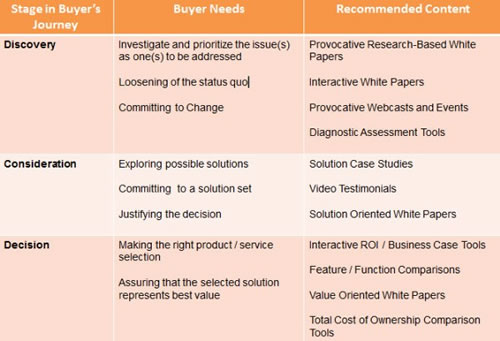
Many analysts have given names to these changed buying journeys. Altimeter Group talks about the ‘dynamic customer journey’, for instance as you can see in the presentation here. Most analysts have also made graphics trying to express that changed customer journey. You can find them on the sites and blogs of companies such as Altimeter, Gartner, Dachis Group (now Sprinklr), Forrester and many more (and on some of my other blogs and blog posts).
In 2009 Mckinsey made a nifty page with plenty of videos, information, graphics, etc. about the decision journey of the ’empowered consumer’. And last year, Forrester’s Lori Wizdo posted the new model of the journey below which she called a bit “Seussian” when we briefly talked about it. And the customer journey indeed is a bit more “Seussian”. That’s why working with touchpoints and with an integrated marketing approach as we keep defending is so cool.
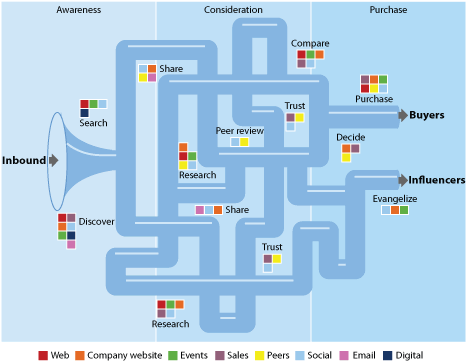
Content marketing strategy and content formats: connecting the dots of the journey
The journey (and multi-channel customer experience) is closely related with the so-called funnel. Experts have been saying that the traditionel funnel is dead for some years now. And that’s correct. However, the funnel has never really existed in reality. It’s a model. And the model is indeed more complex.
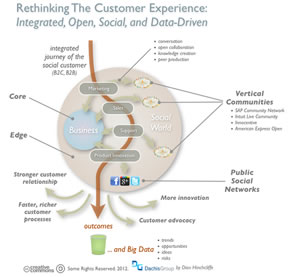
But when building a content marketing strategy (with a focus on organizational goals and the customer) or a strategy whereby relevant content plays the role it deserves, we need to work with the customer journey, mappings with touchpoints and buyer personas, etc. And we need to work with micro-funnels and understand the journey of buyer personas.
That’s why a content strategy (more or less the strategy to execute the content marketing plan) is in a sense different for each buyer persona and it’s certainly different for each business. The average CEO of a major corp, for instance, is not that much of a social B2B buyer (yet) as the maybe younger or more digital-minded marketing manager influencing part of his buying decision.
Today the industry focuses a lot on content formats that work or not from the format perspective and from the viewpoint of opinions, averages (what research mainly is about), etc. But in a content strategy it’s important to focus on the most important things first: content that work for your customers and goals depending on the content they need at each possible stage in their overall journey. And guess what: they don’t care about the formats, they just want the information at that point in time. Content formats can’t be mapped to the customer journey stages in a “this works best then way”. It depends.
On top of that we innovate and test new and hot stuff but usually from a budget perspective it’s more limited. That’s normal. This is not a case against using the hottest content formats, on the contrary. The marketing ROI of less predictable content formats and strategies, in function of the customer journey and the buyer personas, can be amazingly high. But it can also be dramatically low. So you manage risk and make sure you have the fundamentals right in your content marketing strategy first.
How can you do that? Well, it’s part of the content strategy and the overall (content) marketing strategy. But to make it more visual and using the ‘traditional funnel’ instead of funnel it looks very much like the famous content grid by Eloqua, even if such grids are merely models.
And it also looks like the infographic below I stumbled upon , posted by the people of Adido. Content formats matter. But content strategy matters more. And an integrated approach matters even more. But what matters most of all is the customer experience and customer journey. Because that’s what generates sales, improves customer satisfaction and enhances customer experiences. Keep that in mind when considering content formats.
